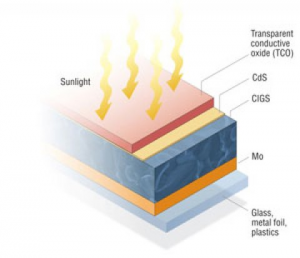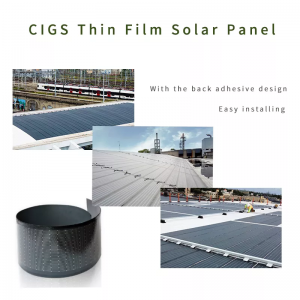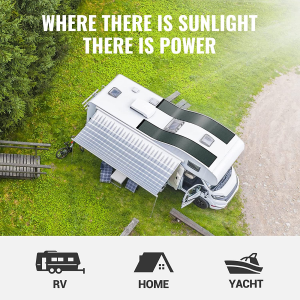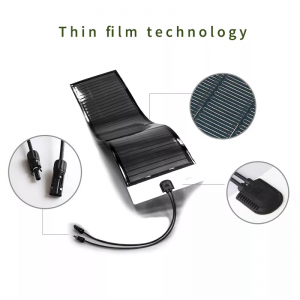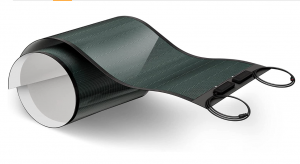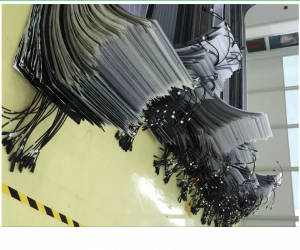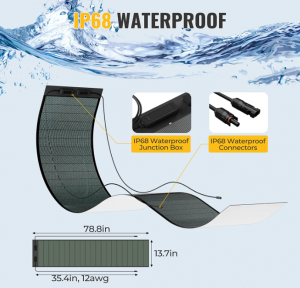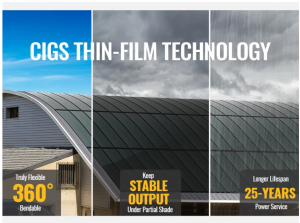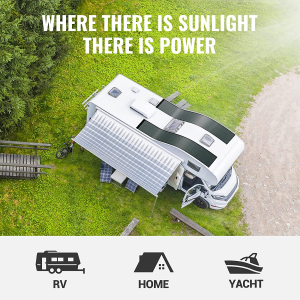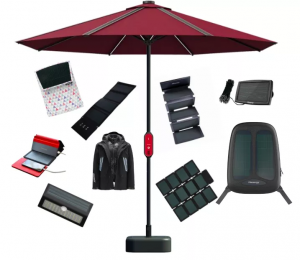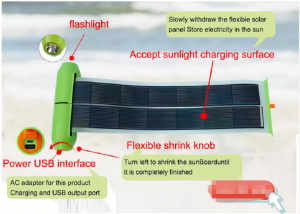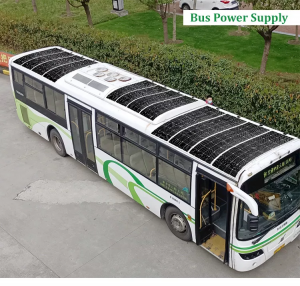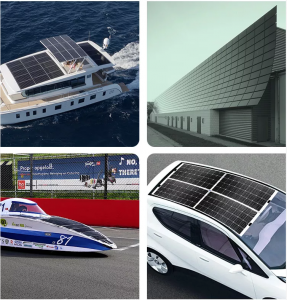TCIGS Technology- Thin film Solar panels
Thin-film solar panels are among the most advanced and efficient power generation technologies created for the solar industry. These photovoltaic (PV) modules include several types according to the materials used to manufacture them. One of the most popular ones is the Copper Indium Gallium Selenide (CIGS) technology.
Copper indium gallium selenide (CIGS) is a thin-film solar cell technology. Unlike silicon-based solar cells, the CIGS thin-film solar cells are more flexible, stable, durable, light-sensitive, and last much longer. Therefore, investing in CIGS may provide you with more peace of mind and long-term benefits.
Materials and manufacturing process of CIGS solar cells
Like many other thin-film solar panels, CIGS PV modules are manufactured using four vital layers:
1)Protective layer 2)Photovoltaic material 3)Conductive sheet 4)Substrate
- CIGS thin film solar panels materials
- CIGS THIN FILM SOLAR PANEL APPLICATIONS
Each layer in the CIGS thin-film solar panel either plays a vital role in the solar energy conversion process or defines the application for the module.There are different processes used in the manufacture of CIGS solar cells, some include Direct-Current (DC) sputtering which is a variation of physical vapor deposition (PVD), Chemical Bath Depositions (CBD), Chemical Vapor Deposition (CVD), or co-evaporation processes.The materials used in each layer of the manufacturing process for the CIGS solar cell are the following:
1.Protective layer
The protective layer is called Transparent Conductive Oxide (TCO) layer. This layer protecting the CdS buffer from external damage is placed in the cell through sputtering or CVD. The TCO layer is manufactured with Intrinsic Zinc Oxide (i-ZnO) placed over the CdS buffer, and then covered with an AZO compound layer made of Aluminum doped Zinc Oxide (Al: ZnO).
2.Photovoltaic material or absorbing layer
The photovoltaic material is the heart of the CIGS solar cell. This is a p-n heterojunction manufactured by placing a p-type layer made from copper indium gallium selenide (CIGS) through co-evaporation and a p-type layer of Cadmium sulfide (CdS) deposited by CBD on top of the CIGS.
3.Conductive sheet
The back contact or conductive sheet is directly placed on top of the substrate, before placing the photovoltaic material. This layer is made by placing molybdenum (Mo) through DC sputtering, resulting in a highly reflective and conductive film working as the main contact for the cell.
4.Substrate
The substrate is the backbone of the CIGS solar cell. This is the first layer where the rest of the materials are placed, defining the flexibility and other properties of the cell. Varying on the desired properties for the module, substrate for CIGS solar cells can be manufactured with glass, a polymer called polyimide, or a metal foil of titanium, stainless steel, or a similar material.
(Knowledage from (solarmagazine.com)
CIGS Thin Film Solar Cells Superior Advantages:
(1) Strong light absorption ability
CIGS solar cells are composed of four elements, Cu (copper), In (indium), Ga (gallium), and Se (selenium), which are composed of chalcopyrite crystals with the best ratio as the absorption layer, which can absorb a wide range of spectral wavelengths. Amorphous silicon solar cells can absorb the visible spectrum range of light, and can also cover the infrared light region with wavelengths between 700 and 1200 nm, that is, the longest time that can absorb light and generate electricity in a day, CIGS thin film solar cells and the same wattage level. Compared with crystalline silicon solar cells, it can exceed 20% of the total power generation per day
(2) High stability of power generation
Since crystalline silicon cells have the characteristics of light-induced attenuation in nature, their power generation efficiency will gradually decrease after prolonged exposure to sunlight, while CIGS solar cells have no light-induced attenuation characteristics and have high power generation stability. After crystalline silicon solar cells generate electricity for a long time, there are more or less hot spots, resulting in small power generation and increased maintenance costs, while CIGS solar cells can use an internal connection structure to avoid this phenomenon. Solar cells are less expensive than maintenance required.
(3) High conversion efficiency
According to the National Renewable Energy Labs (NREL) of the United States, the current solar cell conversion efficiency can reach a maximum of 20.2%, while the industry’s highest record can reach 17%, and the general standard is 12%.
(4) Low production cost
The main cost of CIGS solar cells is the raw materials composed of glass substrate and four elements: Cu (copper), In (indium), Ga (gallium), and Se (selenium). Use ultra-clear glass or thin-film conductive glass for solar energy. The four metal elements are not precious metals, and the thickness of the CIGS absorption layer required for each cell panel is not more than 3 μm (microns), the demand for raw materials is not high, and the cost per sheet is very competitive.
(5) Short energy recovery cycle
Solar cells are a good renewable energy technology, which can solve the energy needs of our human beings without polluting the environment, but the production of solar cells itself also needs to consume a certain amount of energy. To assess whether a renewable energy device is truly environmentally friendly, in addition to the conversion efficiency, what is more important is how long it will take for the renewable energy generated by the device to be equivalent to the total energy consumed in the original production, the so-called energy exchange recovery cycle . According to a study by the U.S. Department of Energy, taking a solar device with a 30-year lifespan as an example, the recycling period for crystalline silicon solar cells is 2-4 years, while that for thin-film solar cells is 1-2 years. In other words, each solar power generation system can enjoy a truly pollution-free period of 26 to 29 years, and the use of CIGS solar energy is undoubtedly the best choice.
- CIGS THIN FILM SOLAR PANEL APPLICATIONS
- CIGS Flexible Solar Panel
- ETFE-coated Flexible Solar Panel
- CIGS amorphous silicon thin film flexible solar panel with high demand
- CIGS stands for copper indium gallium selenide
- cigs flexible solar panel with amorphous silicon solar cell
CIGS flexible thin film solar panels technical datas.
PHYSICAL AND MECHANICAL SPECIFICATIONS | |
Length | 2580 mm (101.6 in) |
Width | 1000 mm (39.4 in) |
Thickness, Maximum at J–Box*, Module | 17 mm (0.7 in), 2.5 mm (0.1 in) |
Weight (Module without adhesive) | 5.1 kg (11.1 lb) |
Weight (Module with adhesive) | 6.2 kg (13.7 lb) |
Weight/Area (Module without adhesive) | 1.7 kg/m2 (0.3 lb/ft2) |
Weight/Area (Module with adhesive) | 2.0 kg/m2 (0.4 lb/ft2) |
Junction Box Type | IP68 |
Cable Connections | unpackaged/packed |
Cell Type | Copper Indium Gallium selenide (CIGS) |
Warranty** | 5 year workmanship; 10/25 year power output |
Certifications | CE |
Packaging Info | 10 modules per crate, 40 modules per pallet, 320 modules per 20‘ ISO container, 640 modules per 40‘ ISO container |
Feature:
 Flexible : provide free design space for architects, and can connect with bending surface, meet the aesthetic requirement for BIPV
Flexible : provide free design space for architects, and can connect with bending surface, meet the aesthetic requirement for BIPV
Lightweight: especially suitable for some installation surfaces is sensitive to weight.
Durable: polyester film encapsulated, ultraviolet resistant, moisture resistant, the application which over 10 years under extreme conditions have been proven by research, widely use for satellite, ocean, military various fields.
Without glass: Don’t breakage if stroked by hail, however, monocrystalline silicon or polycrystalline silicon solar modules stocked by hail, maybe need replacement solar modules, if so, will happen much cost. Also can walk on the flexible solar modules freely, it’s easy for installation and maintenance.
Shadow tolerance: good outside working performance under low light condition.
Good self-cleaning: the surface has high pollution resistant, easy clean, climate resistant features, normally; dirt can be discharged clean by rain.
- ETFE-coated Flexible Solar Panel
- flexiblae thin film solar panels working principle
- waterproof thin film solar panels
- flexible CIGS solar cell
- thin-film solar cell
- CIGS thin film solar cells
CIGS Solar Cells APPLICATION
Directly onto metal Standing-Seam roofs
Roof membranes
Roofs rated at less than 5-10kg/m2 additional load
Curved roof / architectural structures
Mobile applications – RVs, Trucks
Landfills
Larger Mobile applications – Boats, Containers
Tensioned-Fabric structures
Corrugated roofs rated at 7-10kg/m2
Elastomeric Coated Roofs
Poles and Towers
Architectural glass
Larger Shingles
- Thin Film Flexible Solar Cell Panel
- cigs thin film solar cell folded solar panel
- Cigs Thin-Film Transparent Thin Film Solar Panel
- Flexible Mono Solar Panel Boat Solar Panel
FAQ
1.What products you have ?
Solar Gel Battery, LifePO4 Lithium Battery, Solar Hybrid Inverter, On-off Grid Inverter, MPPT Solar Controller, Solar Panel, Solar Energy Kit, Solar Home Generator, Solar Street Light, Solar Water Pump , Solar Air Condition.
2.How long to make order ?
When your products are in large stock in our company, we can deliver the goods in about three days.
If your product needs to be customized, we will provide you with a delivery date according to your product model, quantity andother specific details.
3.How to be your agent in my country?
2*40HQ containers or the value of goods over 2 million RMB per month,
We can authorize the agent to you and support you to grow bigger in the market at that time.
4.If broken you change new one for me?
Yes, you could take a video or photo feedback to me, our engineers will give you the most professional solution;
If it is a product quality problem, we can offer free parts and guide replacement during the warranty period.
5.Quality good?
Yes sure. All our products will pass three times quality testing. One is when assemble the products, one is before package and one is before deliver to customers. And we also have perfect after sale service, for those big customers we will offer 0.5% free accessories as after-sale guarantee.
